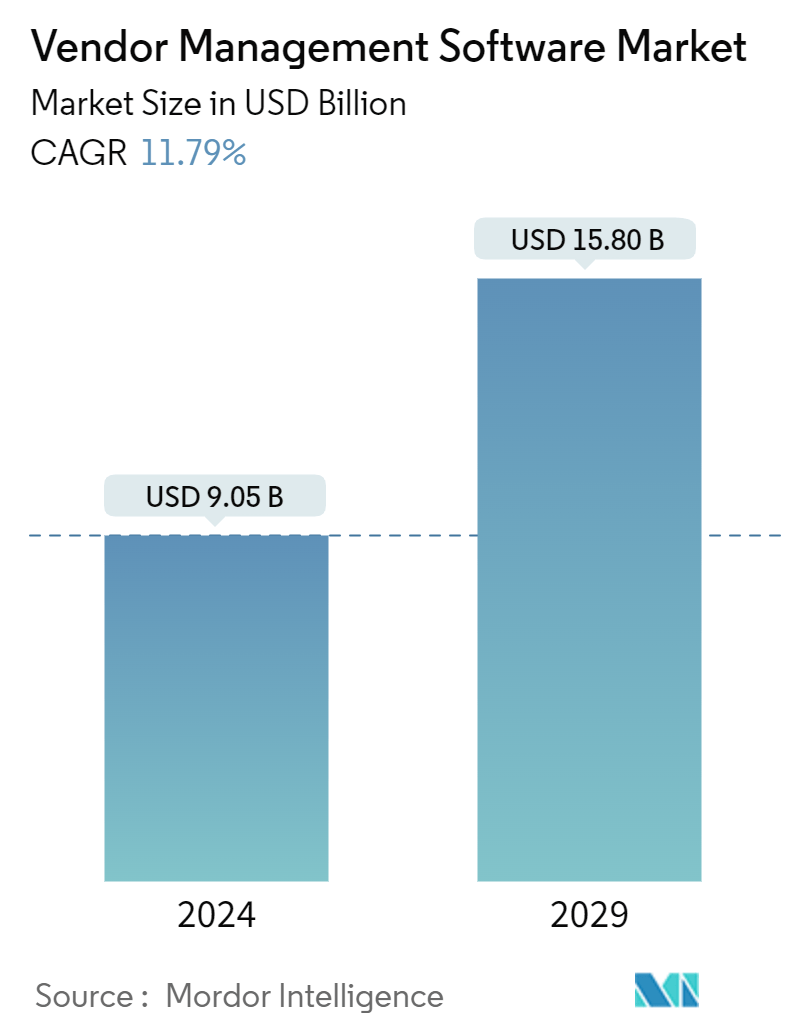Market Size of Vendor Management Software Industry

| Study Period | 2019 - 2029 |
| Market Size (2024) | USD 9.05 Billion |
| Market Size (2029) | USD 15.80 Billion |
| CAGR (2024 - 2029) | 11.79 % |
| Fastest Growing Market | Asia Pacific |
| Largest Market | North America |
Major Players
*Disclaimer: Major Players sorted in no particular order |
Vendor Management Software Market Analysis
The Vendor Management Software Market size is estimated at USD 9.05 billion in 2024, and is expected to reach USD 15.80 billion by 2029, growing at a CAGR of 11.79% during the forecast period (2024-2029).
Vendor management software plays a critical role in streamlining processes associated with vendor relations, enabling companies to maintain efficient, cost-effective supplier networks. This software optimizes vendor selection, tracks performance, manages contracts, and ensures compliance. With the rising complexity of supply chains and increased reliance on third-party vendors, these solutions have become indispensable. Companies across sectors such as retail and BFSI (Banking, Financial Services, and Insurance) invest in vendor management tools for efficient vendor lifecycle management, supplier relationship management, and third-party risk mitigation.
Advancements in Cloud-Based Solutions
- Cloud computing lowers adoption barriers: The market for vendor management software is experiencing rapid growth, driven by advancements in cloud-based solutions. Cloud deployments offer flexibility, scalability, and lower upfront costs, making them attractive, especially for small and medium-sized enterprises (SMEs). These businesses leverage cloud solutions to optimize procurement and supply chain management.
- Enhanced accessibility and scalability: Cloud-based systems allow businesses to monitor vendor compliance and risk management in real time, regardless of location. This accessibility is crucial for companies operating across multiple regions, as cloud-based tools help manage suppliers efficiently across time zones.
- Cost efficiency: Cloud models are cost-effective, reducing the need for high upfront capital investment. Businesses can scale their vendor management solutions according to demand, a feature particularly beneficial for organizations dealing with fluctuating vendor requirements.
- Data protection and compliance: Vendors of cloud-based vendor management software have prioritized data security, implementing strict protocols to ensure the protection of sensitive vendor information. Regular software updates help businesses stay compliant with industry regulations, reducing the risk of non-compliance penalties.
Focus on Administrative Cost Reduction
- Cost reduction through automation: The need to reduce administrative costs is a key driver for adopting vendor management software. By automating processes like vendor onboarding, contract management, and compliance tracking, companies can cut down on administrative time and costs. Automation reduces human errors, enhances efficiency, and improves decision-making through real-time analytics.
- Streamlined administrative workload: Vendor management software automates essential functions such as supplier performance evaluation, risk assessments, and compliance management, significantly reducing paperwork. This digitization enables companies to cut labor costs by eliminating repetitive tasks.
- Data-driven decision-making: Centralizing supplier data on a single platform allows companies to consolidate procurement activities. This enables procurement teams to focus on strategic decisions rather than day-to-day vendor management, improving vendor lifecycle management.
- Improved vendor negotiations: With accurate data insights into supplier performance, companies can negotiate better terms and contracts, further contributing to operational cost savings and overall efficiency.
Adoption of Cloud-Based Vendor Management Solutions
- Growing popularity among businesses: Cloud-based vendor management software is becoming increasingly popular, with businesses turning to these solutions for cost-effective, scalable vendor management tools. Real-time data access and vendor risk management are some of the key features driving cloud adoption, especially in industries with complex supply chains like retail and BFSI.
- Security enhancements: As businesses adopt cloud-based tools, vendor management software providers are focusing on improving security features to ensure that sensitive vendor data remains protected. These solutions also provide regular compliance updates, which is critical in heavily regulated industries such as healthcare and financial services.
- Benefits for global supply chains: Cloud-based solutions are especially advantageous for organizations with international supply chains, as they allow businesses to monitor vendor compliance, manage contracts, and ensure risk mitigation from any location.
- Increased flexibility and reduced capital costs: Unlike traditional on-premise systems, cloud-based vendor management tools offer flexibility and scalability without requiring high upfront investment. This feature is particularly beneficial for SMEs looking to optimize their procurement and vendor management processes while managing their budgets efficiently.
Vendor Management Software Industry Segmentation
A vendor management software provides a platform that allows the user or companies to manage or secure the staffing services on a permanent, temporary or contractual basis. A vendor management system can assist many businesses in managing their external workforce more efficiently. Users can save contact information for vendors, view expenditures, maintain track of contracts, automate vendor onboarding, pay vendors directly, and more with this end-to-end platform.
The vendor management software market is segmented by deployment (on-premise, cloud), end-use industry (retail, BFSI, manufacturing, IT & telecommunications, and other end-user industries), and geography (North America, Europe, Asia Pacific, Latin America, and Middle East and Africa).
The market sizes and forecasts are in terms of value (USD) for all the above segments.
| By Deployment | |
| On-premise | |
| Cloud |
| By End-user Industry | |
| Retail | |
| BFSI | |
| Manufacturing | |
| IT & Telecommunications | |
| Other End-user Industries |
| By Geography | |
| North America | |
| Europe | |
| Asia | |
| Australia and New Zealand | |
| Latin America | |
| Middle East and Africa |
Vendor Management Software Market Size Summary
The Vendor Management Software (VMS) market is poised for significant growth, driven by the increasing need for businesses to streamline supplier relationships and mitigate risks. As organizations seek to enhance decision-making speed and reduce supply chain vulnerabilities, the integration of VMS becomes crucial. The shift towards cloud-based solutions, spurred by government initiatives, further propels market expansion. Companies are also motivated by the necessity to comply with regulations and minimize administrative costs, particularly in regulated industries. However, the high costs associated with implementation and maintenance pose challenges to market growth. The COVID-19 pandemic highlighted the importance of robust vendor management systems, as industries like retail and finance faced disruptions, underscoring the need for effective risk mitigation strategies.
In the retail sector, the reliance on third-party vendors for inventory management necessitates the adoption of VMS to manage risks and maintain supplier relationships. The technological and consumer behavior shifts in the US retail industry are expected to drive demand for VMS solutions. Government funding for small and medium enterprises is anticipated to further boost market growth. In the financial sector, the need for comprehensive third-party vendor management programs is critical for regulatory compliance and risk control. The competitive landscape is marked by the presence of key players such as IBM and SAP SE, who leverage innovation and strategic partnerships to maintain their market positions. Recent acquisitions and product launches, such as Walmart's acquisition of Volt Systems and Cloud5 Communications' vendor management system, highlight the dynamic nature of the market.
Vendor Management Software Market Size - Table of Contents
-
1. MARKET SEGMENTATION
-
1.1 By Deployment
-
1.1.1 On-premise
-
1.1.2 Cloud
-
-
1.2 By End-user Industry
-
1.2.1 Retail
-
1.2.2 BFSI
-
1.2.3 Manufacturing
-
1.2.4 IT & Telecommunications
-
1.2.5 Other End-user Industries
-
-
1.3 By Geography
-
1.3.1 North America
-
1.3.2 Europe
-
1.3.3 Asia
-
1.3.4 Australia and New Zealand
-
1.3.5 Latin America
-
1.3.6 Middle East and Africa
-
-
Vendor Management Software Market Size FAQs
How big is the Vendor Management Software Market?
The Vendor Management Software Market size is expected to reach USD 9.05 billion in 2024 and grow at a CAGR of 11.79% to reach USD 15.80 billion by 2029.
What is the current Vendor Management Software Market size?
In 2024, the Vendor Management Software Market size is expected to reach USD 9.05 billion.

